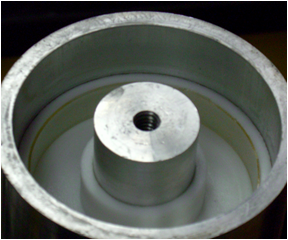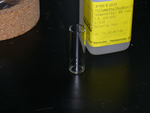


Filtering material through a paper filter or fritted glass is a convenient method to
colect your product, remove unwanted by products, or pass air through a material
to dry the material. This procedure is very simple, requiring approximately 10 minutes to
set up, and scales very nicely.

- Vacuum line
- Vacuum source (house, aspirator)
- Side arm flask (2)
- Buechner funnel
- Filter paper
- Clamps
- 2 hole stopper
- Glass tubing

This material is prepared using a heated centrifuge in a spin casting head. Before
starting material preparation, pre-heat the spin casting head to 60 ~ 65oC.

The first step is preparation of the catalyst solution and reaction solution

- The platinum catalyst solution is prepared as a 1 to 2% weight/weight (w/w) solution
in methylene chloride. Typically, this solution is prepared in quantities of 100 to 200uL in a brown vial and stored
in the refrigerator.
- Example calculation for 1% (w/w)solution: Add 2 mg of the platinum
catalyst to brown glass vial. Add methylene
chloride drop wise until the total mass is 100 mg. This will be enough to prepare 5 batches of LCE

Glass vial used in preparation of catalyst solution. The white crystalline powder
at the front of the vial is the Pt catalyst crystals
Setup
A typical vacuum filtration setup is shown in the first cartoon in the image gallery.
The filtration funnel is connected to the left hand side flask, while right hand side flask
serves as a trap to collect solvent. The two flasks are connected using a vacuum line.
A second vacuum line connects the trap flask to the vacuum source, such as an aspirator.
If working with volatile or unpleasant smelling chemicals, set up the equipment in a fume hood.
Clamp the flasks at the neck or use a flask weight. When the vacuum is turned on, it can deliver
place a surprising of torque, knocking it over. This is especially important for smaller flask
Use vacuum line to connect the two flasks to each otherNext take the 1 hole rubber stopper for
trap flask and a piece of glass tubing that fits snuggly in the rubber stopper.
A glass pipette can work nicely for this. Place a few drop of glycerol,
or any other slippery soap or oil, on the inside of the stopper and on the glass tube.
Insert the tube using a gentle twisting motion. Be very careful at this step
so you don't break the glass and have it go in your hand Connect one end of the
second vacuum hose to the trap funnel, and the other end to the vacuum source.
Place the adaptor and the funnel in the 1st flask. Turn on the vacuum to check
the connectionsPlace the filter paper in the flask. Wet the filter paper with
the solvent you are using to make a seal between the filter paper and the funnel surface.



















































